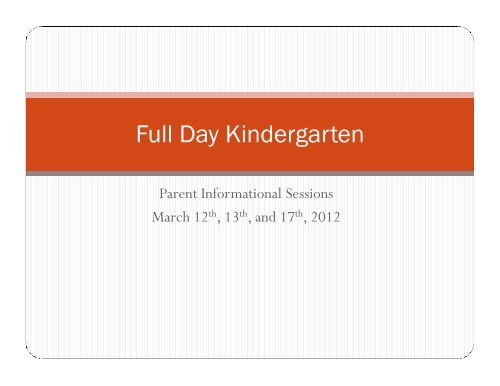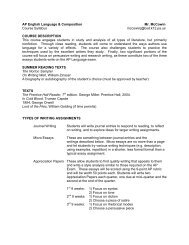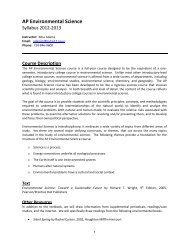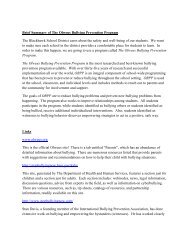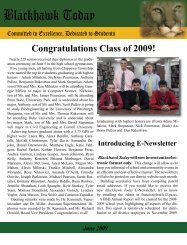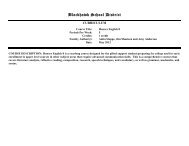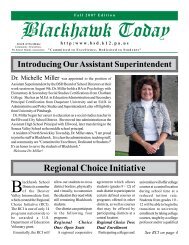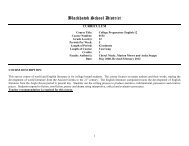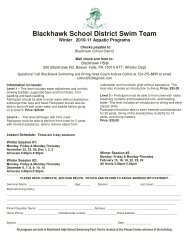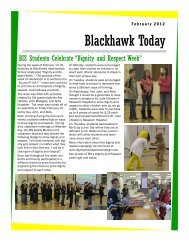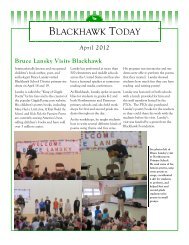Full Day Kindergarten - Blackhawk School District
Full Day Kindergarten - Blackhawk School District
Full Day Kindergarten - Blackhawk School District
Create successful ePaper yourself
Turn your PDF publications into a flip-book with our unique Google optimized e-Paper software.
<strong>Full</strong> <strong>Day</strong> <strong>Kindergarten</strong><br />
Parent Informational Sessions<br />
March 12 th , 13 th , and 17 th , 2012
Introductions<br />
Dr. Michelle Miller, Superintendent<br />
Mrs. Nancy Bowman, Curriculum Director<br />
Mrs. JaneAnn Fucci, Primary Principal<br />
Mr. Tom Nulph, Extended <strong>Day</strong> <strong>Kindergarten</strong><br />
Teacher<br />
Current <strong>Kindergarten</strong> Teachers:<br />
Mrs. Susan Badzik, Northwestern<br />
Mrs. Amy Cienkowski, Patterson<br />
Mrs. Dawn Kinger, Northwestern<br />
Mrs. Jenn Sharek, Patterson<br />
Mrs. Erica Shildt, Northwestern
•Rationale<br />
Today’s Agenda<br />
•Curriculum<br />
•Differences between <strong>Full</strong> <strong>Day</strong><br />
and Half <strong>Day</strong><br />
•Transitioning to <strong>Full</strong> <strong>Day</strong> <strong>Kindergarten</strong> for students<br />
•Questions and Answers<br />
•Parent Feedback<br />
Feedback can be provided verbally or by using the forms you were<br />
provided.
<strong>Full</strong> <strong>Day</strong> versus Half <strong>Day</strong><br />
• Current Program<br />
• Half <strong>Day</strong>: 9:15 - 11:50 or 1:05-3:40<br />
• Academics fill most of time<br />
• Related Arts and Enrichment: Art,<br />
Music, Computer, PE, Library are<br />
taught by classroom teacher<br />
• Teachers have 40+ students and<br />
families to communicate with<br />
• Extended <strong>Day</strong> option at NW for<br />
approximately 20 students who are<br />
identified as at-risk (Not at PPS)<br />
• Proposed <strong>Full</strong> <strong>Day</strong><br />
• <strong>Full</strong> <strong>Day</strong> 9:15 - 3:40<br />
• Deliver same academics but<br />
enhance learning opportunities<br />
• More time for remediation and<br />
enrichment<br />
• More time for socialization and<br />
authentic language development<br />
• Related Arts would be added: Art,<br />
Music, PE, Computer, Library,<br />
and Science taught by specialists<br />
• Teachers would have 20+ students<br />
and parents to focus on<br />
• Support services: Gifted, PT, OT,<br />
Speech, etc… greater flexibility<br />
to schedule support services<br />
during non-academic times
Why <strong>Full</strong> <strong>Day</strong> <strong>Kindergarten</strong> Now?<br />
• Over 350 <strong>School</strong> <strong>District</strong>s in PA provide <strong>Full</strong> <strong>Day</strong><br />
<strong>Kindergarten</strong> (out of 500)<br />
• Cost of <strong>Full</strong> <strong>Day</strong> <strong>Kindergarten</strong>: Personnel Costs<br />
• Early retirement incentive: 15 retirees as of January 2012<br />
• Currently: 4 <strong>Kindergarten</strong> Teachers teaching 8 sections plus one<br />
Extended <strong>Day</strong> <strong>Kindergarten</strong> teacher (Total 5 teachers)<br />
• Personnel Needed for <strong>Full</strong> <strong>Day</strong> <strong>Kindergarten</strong>:<br />
• Need 7-9 kindergarten teachers<br />
• Use Title I teacher and Extended <strong>Day</strong> <strong>Kindergarten</strong> teacher<br />
• Move 1-3 teachers from another grade level
<strong>Full</strong> <strong>Day</strong> <strong>Kindergarten</strong> rationale<br />
<br />
<br />
<br />
<br />
<br />
<br />
<br />
Consistent findings appeared concerning the positive effect on academic achievement for<br />
children identified as being at risk<br />
Children in the all-day programs scored higher on the achievement test than those in half-day<br />
programs on every item tested.<br />
Both parents and teachers whose children were enrolled in all-day kindergarten were generally<br />
satisfied with the programs and believed that all-day kindergarten better prepared children for<br />
first grade<br />
Teachers and parents also indicated a preference for all-day kindergarten because of the more<br />
relaxed atmosphere, more time for creative activities, and more opportunity for children to<br />
develop their own interests<br />
Parents felt that the all-day kindergarten schedule benefited their children socially<br />
Teachers surveyed felt that the all-day program provided more time for individual instruction<br />
They also indicated that they had more time to get to know their children and families, thus<br />
enabling them to better meet children's needs<br />
<br />
From the US Department of ED
Curriculum Changes<br />
PA Standards to Common Core Standards:<br />
From surface of many topics to deeper and more<br />
comprehensive understanding
Math Curriculum: Common Core<br />
<br />
Counting and Cardinality<br />
• Know number names and the count sequence.<br />
• Count to tell the number of objects.<br />
• Compare numbers.<br />
<br />
Operations and Algebraic Thinking<br />
• Understand addition as putting together and adding to, and understand subtraction as taking apart and taking from.<br />
<br />
Number and Operations in Base Ten<br />
• Work with numbers 11-19 to gain foundations for place value.<br />
<br />
Measurement and Data<br />
• Describe and compare measurable attributes.<br />
• Classify objects and count the number of objects in each category<br />
<br />
Geometry<br />
• Identify and describe shapes.<br />
• Analyze, compare, create, and compose shapes.
Math Curriculum: Changing Standards<br />
Mathematical Practices<br />
• 1. Make sense of problems and persevere in solving them.<br />
• 2. Reason abstractly and quantitatively.<br />
• 3. Construct viable arguments and critique the reasoning of others.<br />
• 4. Model with mathematics.<br />
• 5. Use appropriate tools strategically.<br />
• 6. Attend to precision.<br />
• 7. Look for and make use of structure.<br />
• 8. Look for and express regularity in repeated reasoning.
ELA Curriculum: Common Core<br />
<br />
<br />
<br />
<br />
Print Concepts<br />
• Demonstrate understanding of the organization and basic features of print. Follow words from left to right, top to bottom, and page by page.<br />
• Recognize that spoken words are represented in written language by specific sequences of letters.<br />
• Understand that words are separated by spaces in print.<br />
• Recognize and name all upper- and lowercase letters of the alphabet<br />
Phonological Awareness<br />
• Demonstrate understanding of spoken words, syllables, and sounds (phonemes). Recognize and produce rhyming words.<br />
• Count, pronounce, blend, and segment syllables in spoken words.<br />
• Blend and segment onsets and rimes of single-syllable spoken words.<br />
• Isolate and pronounce the initial, medial vowel, and final sounds (phonemes) in three-phoneme (consonant-vowel-consonant, or CVC) words.1<br />
(This does not include CVCs ending with /l/, /r/, or /x/.)<br />
• Add or substitute individual sounds (phonemes) in simple, one-syllable words to make new words.<br />
Phonics and Word Recognition<br />
• Know and apply grade-level phonics and word analysis skills in decoding words. Demonstrate basic knowledge of letter-sound correspondences<br />
by producing the primary or most frequent sound for each consonant.<br />
• Associate the long and short sounds with the common spellings (graphemes) for the five major vowels.<br />
• Read common high-frequency words by sight (e.g., the, of, to, you, she, my, is, are, do, does).<br />
• Distinguish between similarly spelled words by identifying the sounds of the letters that differ.<br />
Fluency<br />
• Read emergent-reader texts with purpose and understanding.
ELA Curriculum: Changing Standards<br />
<br />
<br />
<br />
<br />
Key Ideas and Details<br />
1. Read closely to determine what the text says explicitly and to make logical inferences from it; cite specific textual evidence<br />
when writing or speaking to support conclusions drawn from the text.<br />
2. Determine central ideas or themes of a text and analyze their development; summarize the key supporting details and ideas.<br />
3. Analyze how and why individuals, events, and ideas develop and interact over the course of a text.<br />
Craft and Structure<br />
4. Interpret words and phrases as they are used in a text, including determining technical, connotative, and figurative meanings,<br />
and analyze how specific word choices shape meaning or tone.<br />
5. Analyze the structure of texts, including how specific sentences, paragraphs, and larger portions of the text (e.g., a section,<br />
chapter, scene, or stanza) relate to each other and the whole.<br />
6. Assess how point of view or purpose shapes the content and style of a text.<br />
Integration of Knowledge and Ideas<br />
7. Integrate and evaluate content presented in diverse media and formats, including visually and quantitatively, as well as in words. 1<br />
8. Delineate and evaluate the argument and specific claims in a text, including the validity of the reasoning as well as the relevance<br />
and sufficiency of the evidence.<br />
9. Analyze how two or more texts address similar themes or topics in order to build knowledge or to compare the approaches the<br />
authors take.<br />
Range of Reading and Level of Text Complexity<br />
10. Read and comprehend complex literary and informational texts independently and proficiently.
Curriculum Revisions<br />
Curriculum will be revised in grades 1-12 due to full day<br />
kindergarten experience AND common core standards
Current Related Arts Offerings<br />
Art, Physical Education, Computer, and Music are taught by<br />
the classroom teacher.<br />
There is computer curriculum for <strong>Kindergarten</strong> teachers to<br />
follow.<br />
All other experiences in art, music, and physical education<br />
All other experiences in art, music, and physical education<br />
are determined by the classroom teacher.
Proposed Related Arts and Enrichment<br />
Opportunities<br />
One forty minute period per six day cycle:<br />
Art<br />
Music<br />
Physical Education<br />
Library<br />
Computer<br />
Science
Proposed Related Arts and Enrichment<br />
Opportunities<br />
30 minute daily recess<br />
Additional daily small group instruction in both reading and<br />
math<br />
Scheduled times for student social interaction at play (recess)<br />
and at structured classroom activities (lunch, free choice<br />
activities and centers)<br />
Daily quiet cool down time (story time)<br />
Hands-on development of concepts and further enrichment<br />
opportunity<br />
Increased opportunities through incidental learning and<br />
informal curriculum (citizenship)
Transitioning in the Primary
Transition<br />
Yes, students will be tired. Typical for all primary students.<br />
Usually lasts first month of school.<br />
Toughest time: First two weeks<br />
Hardest day: 2 nd Monday of school<br />
Never had a student with significant difficulty in transitioning<br />
to full day.<br />
Address K-2 individual needs if transition is problematic:<br />
tired, ill, separation issues, etc…
Transitioning to <strong>Full</strong> <strong>Day</strong><br />
First two weeks, provide half day experience with lunch at<br />
school (approximately 9:15-12:00)<br />
During afternoons, parents will be scheduled to meet with<br />
the kindergarten teacher to discuss concerns, provide parent<br />
input and for the teacher to individually assess students.
Possible Option for Parents<br />
Provide one half day session at both PPS and NW (AM sessions).<br />
Parents are responsible for transportation at the end of the school<br />
session.<br />
Minimum of 15 students to run session.<br />
Class size will not exceed the class size of the full day classrooms.<br />
If requests exceed this limit, students who are identified as<br />
“kindergarten ready” as indicated on the DIAL kindergarten<br />
screener will be placed in a lottery for class placement.<br />
Reduced need for <strong>Kindergarten</strong> teachers from 0-2 (depending on<br />
enrollment).<br />
Provides parents choice.


